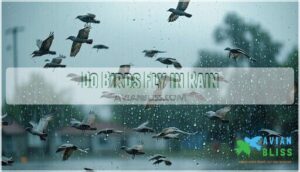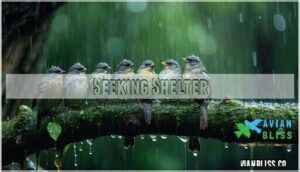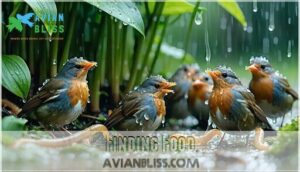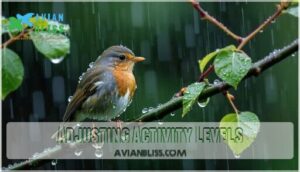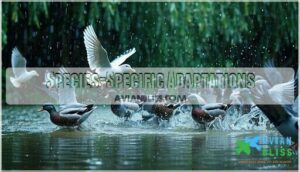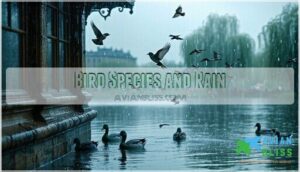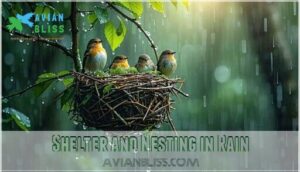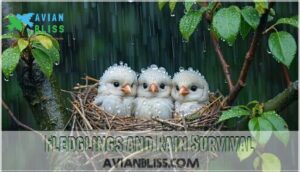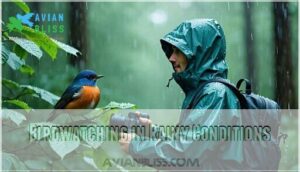This site is supported by our readers. We may earn a commission, at no cost to you, if you purchase through links.

Light drizzle barely bothers most birds – they’ll keep flying like it’s nothing.
However, heavy rain creates real challenges.
Their feathers get waterlogged, making flight harder and more tiring.
Rain also reduces visibility and makes it tough to spot food or predators.
You’ll notice birds adjust their flying style during wet weather – they fly lower, change their wing beats, and sometimes take zigzag paths to cut through wind and rain.
Different species handle rain differently, with waterfowl being natural rain champions while smaller songbirds often seek shelter until storms pass.
Table Of Contents
- Key Takeaways
- Birds Flying in Rain
- Do Birds Fly in Rain
- Bird Behavior in Rain
- Flying Techniques in Rain
- Birds and Rain Effects
- Waterfowl in Rainy Weather
- Bird Species and Rain
- Shelter and Nesting in Rain
- Fledglings and Rain Survival
- Birdwatching in Rainy Conditions
- Frequently Asked Questions (FAQs)
- Can birds fly in heavy rain?
- Do birds fly if they are wet?
- Can birds fly in storms?
- Why do birds avoid flying during a rainstorm?
- How do birds live in the rain?
- Does rain affect birds?
- Can birds fly if they get wet?
- Is it okay to leave bird feeders out in the rain?
- Where do the birds go when it’s raining?
- Is it good to go birding in the rain?
- Conclusion
Key Takeaways
- You’ll see birds flying in light rain without much trouble, but heavy downpours make flight difficult and energy-draining due to waterlogged feathers and reduced visibility.
- Birds adapt their flying techniques during wet weather by flying lower to the ground, using zigzag patterns to navigate wind and rain, and adjusting their wingbeat frequency to maintain stability.
- Different species handle rain differently – waterfowl like ducks and geese are natural rain champions with waterproof feathers, while smaller songbirds often seek shelter until storms pass.
- You can still go birdwatching in light rain since birds emerge to feed on worms and insects that surface after storms, but you’ll need waterproof gear and should focus on sheltered areas where birds gather.
Birds Flying in Rain
You’ve probably seen birds flying in the rain, but it’s not as easy for them as it seems.
They face challenges like wet feathers, reduced visibility, and stronger winds, which make flight harder and use up more energy.
Risks and Challenges
Rain creates real challenges for birds.
Heavy downpours disrupt flight and foraging, straining survival.
- Hypothermia risk rises as wet feathers lose insulation.
- Foraging limits mean less food for energy.
- Flight difficulty increases with wet, heavy plumage.
- Visibility reduction makes spotting predators and food harder.
- Energy expenditure skyrockets as traversing turbulent air demands more effort from already stressed birds.
Adaptations and Techniques
Birds manage rain with incredible adaptations.
Waterproof feathers, enhanced by feather oiling from the uropygial gland, repel water.
The nictitating membrane protects their eyes, keeping vision sharp.
Wing pivoting lets air pass during flight, while their metabolic rate stays high to maintain warmth.
Some adopt a "rain pose," sleeking feathers and pointing beaks downward, minimizing exposure to heavy raindrops, utilizing their waterproof feathers and maintaining a high metabolic rate.
Atmospheric Conditions
Flying during rain isn’t easy for birds because low-pressure systems and high humidity reduce air density, making aerodynamic lift harder to achieve.
Raindrops and shifting wind patterns create tough flying conditions.
Storm conditions disrupt air currents, forcing constant adjustments, which makes flying even more challenging due to the need to conserve energy, so most birds perch during bad weather, waiting for better flying conditions when the air is denser and calmer.
Do Birds Fly in Rain
When it starts pouring, you might wonder if birds can still take flight.
The answer depends on the intensity of the rain and the species.
Light drizzle? Many birds like pigeons and swallows keep flying, adapting their wing movement to stay airborne.
Heavy rain, though, is a tougher challenge.
Wet feathers lose airflow efficiency, making bird flight slower and tiring.
Some species, like hummingbirds, adjust by increasing their wingbeat frequency to counteract rain effects.
Others, such as swans or geese, handle rain better due to their size and waterproof feathers.
Weather patterns also play a role—low-pressure systems during storms affect air density, which reduces lift.
When weather impact worsens, most birds perch, conserving energy until the rain passes.
Bird Behavior in Rain
When it rains, birds change their behavior to survive the challenges of wet weather. They seek shelter, adjust their activity levels, and focus on finding food when the rain eases.
Rain transforms birds into resourceful survivors, triggering clever adaptations that showcase nature’s remarkable resilience and ingenuity.
Seeking Shelter
When rain pours, birds adapt with clever sheltering behaviors to stay safe.
They tuck into dense shrubs or tree trunks, minimizing exposure. Urban shelters like eaves and bridges offer handy cover.
Group sheltering happens too, showing teamwork. Resourceful survival strategies like using natural shelter materials or competing for prime spots reveal their instincts.
Rain doesn’t stop their flight for safety!
Finding Food
When rains hit, food scarcity becomes a challenge.
Birds brave the conditions, seeking insects and worms that surface. Post-rain foraging includes a feeding frenzy, as energy reserves need replenishing.
Worm abundance attracts many, while insect reappearance provides key nutrition. Some stay sheltered during storms, conserving energy for this critical hunt once food availability improves.
Adjusting Activity Levels
Birds adapt their activity patterns during rain to balance energy conservation.
You’ll notice them perched in sheltered spots, conserving energy while waiting for better weather conditions.
Pre-storm feeding prepares them for limited foraging.
After rain, there’s often a frenzy of activity—urgent foraging, post-rain singing, and preening.
These avian adaptations highlight how bird behavior shifts to survive changing weather conditions, showcasing their ability to conserve energy and engage in post-rain singing, ultimately demonstrating avian adaptations.
Flying Techniques in Rain
When birds fly in the rain, they adjust their wing movements to counteract the drag from raindrops.
They also fly closer to the ground, where wind is calmer and visibility is better, which can be considered a complete adjustment to their flight behavior.
Wing Movement Adjustments
Flying makes birds adjust their wing dynamics for survival.
In wet weather, birds tweak their wingbeat frequency to counter raindrop drag.
They also pivot feathers during upstrokes, letting air through, and use the perfect angle of attack for balanced flight.
Feather pivoting reduces drag, while techniques like gliding or changing wing shape guarantee flight stability despite the rain’s challenges.
Zigzag Flying Patterns
When raindrops tumble, zigzag flying patterns come in handy.
By weaving left and right, birds handle flight instability caused by weather conditions while practicing predator evasion.
This bird flight technique lets them make quick course corrections and adapt to wind compensation.
Zigzagging isn’t just graceful—it’s an energy-efficient way to navigate rain’s challenges while staying alert to dangers.
Birds also utilize waterproof feather adaptations to help them fly in the rain, which is a key factor in their ability to thrive in various weather conditions, making them highly energy-efficient.
Close-to-Ground Flight
When zigzagging isn’t enough, birds rely on close-to-ground flight during rainy weather.
Staying low helps with energy conservation and predator avoidance, despite challenges like ground turbulence and limited visibility.
This wet weather strategy aids:
- Low-altitude foraging for food.
- Avoiding stronger winds higher up.
- Reducing drag caused by raindrops.
- Staying hidden from predators.
- Plotting changing wind patterns effectively.
Birds and Rain Effects
Rain affects birds in many ways, from soaking their feathers to making flight harder.
You’ll notice they conserve energy, protect their nests, and adjust behaviors to survive both light and heavy rainfall.
Light and Heavy Rain
Rain intensity matters a lot for birds in rain.
Light rain is manageable, thanks to waterproof feathers and steady flight.
Heavy rain, though, impacts flight stability and energy.
Species variation plays a role—hummingbirds resist rainy conditions better than pigeons, for example.
Weather thresholds often mean smaller birds shelter during heavy rain, avoiding soaked wings and conserving strength.
To help birds in these conditions, consider providing rain-resistant birdhouses to support their needs in heavy rain and promote flight stability and overall well-being with steady flight.
Feather Care and Maintenance
Birds rely on preening to keep their feathers in top shape.
Using oil from the uropygial gland, they maintain waterproof feathers while ensuring flexibility.
Powder down feathers add extra waterproofing.
Feather structure, with overlapping tips, sheds water efficiently.
You can even purchase specialized preening oils for your pet bird.
Constant preening, aided by waterproofing mechanisms, keeps feathers ready for flight and insulation, even during rainy weather.
Energy Expenditure and Conservation
Keeping feathers waterproofed is only part of a bird’s rain strategy.
Wet conditions increase bird energy expenditure as they balance thermoregulation costs and limited foraging.
Flight efficiency drops, forcing them to conserve energy by shelter selection.
Uropygial gland oil is essential for waterproofing.
Post-rain recovery becomes critical as they rely on foraging strategies and other bird rain adaptations to rebuild energy lost during soggy challenges.
Waterfowl in Rainy Weather
You’ll notice waterfowl, like ducks and geese, are well-suited for rainy weather with their waterproof feathers and webbed feet.
They can keep swimming or even fly in light rain, but during heavy rain, they often rest to conserve energy and avoid waterlogged wings, which helps them to conserve energy.
Swimming and Flying Abilities
Waterfowl excel in rainy weather thanks to their unique features.
Their webbed feet power smooth Rain Swimming, while Feather Buoyancy keeps them afloat effortlessly.
Here’s what gives them an edge:
- Webbed Feet: Propel through water with ease.
- Feather Buoyancy: Insulation and floating power.
These birds might even require a waterfowl buoyancy vest in certain conditions.
- Waterfowl Aerodynamics: Efficient flight in windy rain.
- Aquatic Takeoff: Quick lift from water.
- Adapted flight patterns: Stability in storms.
Resting and Energy Conservation
When rain pours, waterfowl focus on conserving energy. They prioritize Shelter Selection, huddling under vegetation or floating calmly to avoid overexertion.
Adopting a Rain Pose helps minimize exposure and maintain body heat. Lowering activity levels and relying on bird rain strategies guarantee survival.
Their efficient Metabolic Rate keeps them warm while using bird energy management techniques to endure tough weather. Birds also use waterproof feathers and preen glands to stay dry in the rain.
| Behavior | Purpose | Example Actions |
|---|---|---|
| Shelter Selection | Reduces exposure | Huddling under foliage, finding cover |
| Rain Pose | Heat conservation | Sleeking feathers, tucking head |
| Energy Minimization | Preserves resources | Staying still, floating calmly |
Species-Specific Adaptations
When resting in rain, different birds show fascinating weather adaptations.
Ducks and geese float serenely with waterproof feathers, while pigeons rely on unique plumage to shed water.
Gulls master gusty winds with steady wing beats, and petrels exhibit swift flight through storms using long, narrow wings.
- Gulls adjust their strategies to strong winds.
- Pigeons rely on weather-resistant plumage.
- Waterfowl use buoyant feathers for swimming.
Bird Species and Rain
You’ll notice different bird species react to rain in unique ways, depending on their size, wings, and habits.
Waterfowl swim comfortably, swifts glide with ease, and pigeons or gulls adapt their flight to stay safe and conserve energy, which helps them react to rain in their own ways.
Waterfowl and Their Abilities
Ducks and geese handle rain like pros.
Their waterproof feathers, coated with oil, repel water, keeping them light.
Their webbed feet make aquatic foraging easy, even in downpours.
With natural buoyancy, waterfowl float effortlessly, while rain flight showcases their strong wings.
Unlike smaller birds, they thrive in wet weather, balancing energy conservation and survival perfectly.
They’re built for the splash!
Swifts and Swallows
Swifts and swallows, both aerial insectivores, show remarkable flight adaptations for weather challenges.
With streamlined bodies, swifts glide efficiently, even traversing storms. Swallows adapt by flying closer to the ground during rainy weather.
Migration patterns also help both species escape unfavorable conditions. Colony nesting offers added protection, but prolonged rain makes feeding tough as fewer insects are available to sustain bird flight.
Colony nesting and migration patterns are crucial for survival, offering protection and a means to escape harsh weather.
Pigeons and Doves
Pigeons and doves handle rain with unique flair. Their feathers repel water, thanks to natural oils, ensuring smooth flights during light showers.
- Urban pigeon behavior: Sheltering under eaves or bridges.
- Pigeon navigation skills: Wind disruptions challenge them.
- Pigeon feather structure: Optimized for waterproofing.
- Dove species comparison: Some dive for dense foliage.
- Dove courtship rituals: Stall temporarily in bad weather.
Gulls and Petrels
Gulls and petrels excel in rain thanks to their waterproof feathers and clever adaptations.
Gulls rely on efficient flight patterns, while petrels navigate stormy seas with precision. Petrels even use wind to aid foraging over oceans.
Both species adapt brilliantly to wet weather, demonstrating unique skills to survive rain’s challenges, making them versatile adapters and precision foragers.
| Feature | Gulls | Petrels |
|---|---|---|
| Feathers | Waterproof | Waterproof |
| Habitat | Coastal Areas | Open Ocean |
| Flight Skill | Efficient Flight | Storm Navigation |
| Diet | Opportunistic | Fish, Squid |
| Behavioral Trait | Versatile Adapters | Precision Foragers |
The combination of efficient flight and storm navigation skills allows these birds to thrive in various environments, from coastal areas to the open ocean.
Shelter and Nesting in Rain
When it rains, birds seek shelter in dense shrubs, tree trunks, and sturdy branches to stay dry and safe.
Protecting their nests from heavy rain and wind is critical for keeping their eggs and chicks secure.
Dense Shrubs and Thickets
Dense shrubs and thickets are a bird’s umbrella during rainstorms.
These natural shelters provide predator avoidance, nest protection, and even a microclimate to keep birds warm and dry.
Species preference varies, but most birds utilize these habitats to wait out storms, conserve energy, and find nearby food availability once the rain eases, which is essentially nature’s perfect raincoat for avian survival.
Tree Trunks and Branches
Tree trunks and branches are natural rain shelters for birds.
Thick trunk diameter and rough bark texture provide secure perches, even in storms. Dense branches block rain, while hollow or rotting wood doubles as dry hiding spots.
Foraging birds benefit from insect habitats within decayed wood. These areas become life-saving spots, showcasing how birds adapt for rain survival with clever choices.
Protecting Nests From Damage
Birds take clever steps to protect nests from damage during rain.
They rely on strong materials and careful construction to maintain structural nest integrity.
Common techniques include:
- Choosing thick branches for stability.
- Using water-resistant materials like moss or feathers.
- Adding camouflage and concealment to avoid predators.
- Engaging in parental nest defense against threats.
- Conducting post-rain nest repair for lasting shelter, which helps in maintaining the structural nest integrity and ensuring the nest remains a safe lasting shelter.
Fledglings and Rain Survival
Young birds face real challenges in the rain, especially since their feathers aren’t fully waterproof yet.
They rely on their parents for warmth, food, and protection to survive wet, chilly weather.
Fledglings’ Ability to Fly
Fledglings often struggle to fly in wet weather since their feathers aren’t fully waterproof yet.
Rain can make their wings heavy, slowing flight development and making escape harder.
Parental care plays a key role, as parents keep chicks sheltered and fed during storms, which tests post-fledging survival, but careful flight practice helps fledglings adapt gradually to rainy conditions.
Vulnerability to Hypothermia
When weather conditions turn wet and chilly, chick vulnerability skyrockets.
Wet feathers lose their insulation, making it harder to stay warm.
Smaller birds face hypothermia risks faster since size matters in conserving heat.
Without enough metabolic rates to counteract the cold, finding shelter becomes an urgent need.
Bird adaptations like preening oil help, but prolonged exposure can still threaten survival.
Parental Care and Protection
When rain falls, bird parenting kicks into high gear. Parents shield nests and fledglings with relentless care.
Here’s how they adapt:
- Rotate incubation shifts to keep eggs dry.
- Use brooding behavior to warm chicks under wings.
- Guard nests defensively against predators in wet weather.
- Shelter fledglings under dense foliage.
- Post-fledging care guarantees survival through feeding chicks and guiding them, which is a crucial part of bird parenting and ensures the young ones receive proper post-fledging care and are guided to survival.
Birdwatching in Rainy Conditions
You can still watch birds during rainy weather, but you’ll need waterproof gear and patience since most birds seek shelter during heavy downpours.
Light rain often brings the best viewing opportunities as birds emerge to feed on worms and insects that surface after storms, making it an ideal time for bird watching.
Tips for Observing Birds
Watching birds during rainy weather requires patience and preparation.
Position yourself near sheltered areas where species gather, like dense shrubs or building eaves. Keep movements slow and quiet to avoid startling wet birds.
Use field guides to identify unfamiliar species you’ll encounter. Practice ethical birding by maintaining safe distances from vulnerable birds seeking shelter during storms.
Choosing The Right Equipment
When rain clouds gather, proper gear makes all the difference.
Waterproof binoculars protect your vision while rain-resistant camera gear captures those special moments.
Pack field guides in waterproof bags and consider audio recorders for identifying calls when visibility drops.
Quality rain protection keeps you comfortable, and portable rain shelters extend your birdwatching sessions when weather turns unpredictable.
Enhancing Birdwatching Experience
Three simple steps transform ordinary rainy-day birdwatching into extraordinary experiences.
Document your observations for Citizen Science projects while practicing Ethical Birding principles.
Focus on Birdsong Identification when visibility drops, and develop deeper Habitat Appreciation by noticing how different species adapt.
Your Rainy-day Gear investment pays off when you discover unique bird flight patterns and behaviors that fair-weather watchers miss completely.
Birds also employ various flight strategies to cope with the rain.
Frequently Asked Questions (FAQs)
Can birds fly in heavy rain?
Most birds avoid heavy rain because waterlogged feathers increase weight by 25%.
You’ll see them seeking shelter instead, as wet wings lose insulation and make flight energy-expensive, though some larger species can still manage short flights with heavy rain.
Do birds fly if they are wet?
Yes, you’ll see wet birds flying, but they’re working harder.
Their waterlogged feathers lose insulation and create extra weight, making flight more energy-intensive.
Most birds prefer waiting until they’re dry before taking off, as this allows them to fly more efficiently without the burden of waterlogged feathers.
Can birds fly in storms?
When Mother Nature throws her tantrums, you’ll rarely see birds braving severe storms.
They’re smart enough to hunker down and wait it out, as heavy rain makes flying nearly impossible and dangerously exhausting.
Why do birds avoid flying during a rainstorm?
Rainstorms create low-pressure systems with less dense air, making lift harder to generate.
You’ll notice birds shelter because wet feathers lose insulation, heavy raindrops create drag, and reduced visibility makes navigation dangerous, due to reduced visibility.
How do birds live in the rain?
When rain hits, you’ll see birds seek shelter under dense foliage, eaves, or tree cavities.
They adopt a sleek "rain pose," pointing bills toward droplets to minimize water exposure while conserving precious energy until conditions improve.
Does rain affect birds?
Oh sure, birds just love getting soaked!
Rain dramatically affects our feathered friends by reducing body temperature, limiting flight ability, disrupting foraging, and forcing them to seek shelter until conditions improve.
Can birds fly if they get wet?
Birds can fly when wet, but it’s tougher work.
Water weighs down their feathers and reduces insulation, making flight harder and less efficient.
They’ll avoid heavy rain when possible to conserve energy.
Is it okay to leave bird feeders out in the rain?
Most backyard bird feeders get wet daily during rainy seasons.
You can leave feeders out, but wet seed spoils quickly and grows mold.
Empty and clean them regularly, or use covered designs to keep food fresh.
Where do the birds go when it’s raining?
When storms hit, you’ll find feathered friends tucked under dense bushes, tree branches, building eaves, and hollow trunks.
They adopt a sleek "rain pose" to minimize water exposure while conserving precious energy.
Is it good to go birding in the rain?
Light drizzle can actually make birding excellent – worms surface, birds forage actively, and you’ll spot species seeking shelter.
However, heavy downpours reduce visibility and bird activity, making it less rewarding for observation.
Conclusion
Like Noah’s ark weathering the storm, birds have mastered the art of surviving rainy conditions through millions of years of evolution.
While some species struggle more than others, most birds adapt their flight patterns and behavior when precipitation arrives.
You’ve learned that birds do fly in the rain, but they’re smart about it – using energy-saving techniques, seeking appropriate shelter, and adjusting their activities based on weather intensity.
Understanding these survival strategies helps you better appreciate nature’s remarkable resilience.

